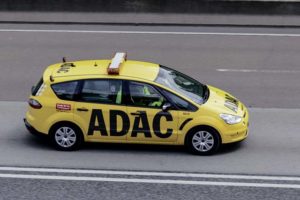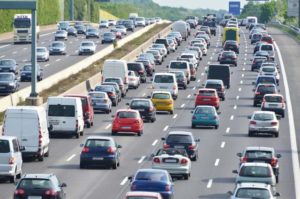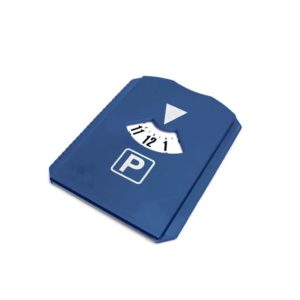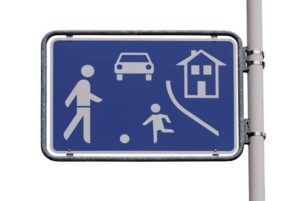For more useful information about living in Germany, read the Find-It Guide 2020 KMC Edition or visit FindItGuide.com
ADAC — “The Yellow Angels”
The German equivalent of AAA (American Automobile Association) is ADAC (Allgemeiner Deutscher Automobil Club). ADAC offers many services for drivers, the most visible of which are the yellow road patrols throughout Germany.
More than 1,600 “Yellow Angels” are employed by ADAC, so help is usually nearby no matter where or when you run into trouble.

By cooperative arrangement with the automobile clubs in other European countries, your ADAC membership covers many services.
It gives you emergency service through-out Europe as well as return to Germany from anywhere in the world in case of illness. An ADAC subscription gives you the services of the road patrol, a monthly magazine, and tourist information.
Your ADAC office can provide computer printouts of the best driving routes, names of hotels and emergency medical service when you’re on the road. They also sell the toll stickers for driving in Austria and Switzerland and toll cards for Italy.
One further service is the loan of tire chains for your ski vacation.
If you break down, mechanics provide free labor and towing services for ADAC members. You pay only for spare parts.
For more information, call 0180-510 11 12. For ADAC service call 22 22 22 from your cell phone or 0180-2 22 22 22 from a landline. Operators speak English as well as German.
Autobahn driving

Before pulling into the left lane to pass, check the rearview mirror very carefully as far back as you can see. Cars traveling at 160-180 km per hour approach suddenly, so when passing, do so quickly and then quickly return to the right lane. Some impatient drivers flash their headlights, use their blinker, and tailgate to pressure slower cars ahead into moving out of the way.
These practices have been outlawed recently, and it is best to ignore this behavior if it is directed at you. (Within the city a driver may flash his lights at you as a signal that you may turn into the street or turn left across his lane of traffic, but do so with caution.)
In case of a breakdown, look for arrows at the top of the white posts lining the road. They’ll lead you to the nearest emergency call box, located every 1.5 to 3 km along the Autobahns. Merely lift the handle and an operator will answer.
Black Ice or “Glatteis”
A particular hazard of driving in Europe in the wintertime is the danger of “black ice” or “Glatteis.” The best way to recognize black ice is by surface reflection, but that dull patch just ahead might be ice also.
Be especially wary in the early morning or late evening and near or on bridges. If you see the patch, take your foot off the gas quickly. Once on an icy section, do not accelerate, brake, gear down or make any sudden change in direction. Keep well behind other cars. If starting to lose control, steer toward the edge of the road where residues of sand and salt might help.
Drinking & driving
German law concerning what constitutes driving a vehicle while under the influence of alcohol is different than American law. It must be understood, however, that there are many variables which alter the effects of alcohol upon a person, i.e., weight of the person, type of alcoholic beverage consumed, etc.
It is therefore difficult to list all conditions and aspects of what constitutes drunken driving.
The important thing is NOT TO DRINK AND DRIVE.
Under German law, it is illegal to operate a vehicle if the blood level is 0.5 per mill or higher. The law imposes a penalty and the withdrawal of the driver’s license for specified periods of time depending upon the gravity of each violation.
Parking
Most city parking in Germany is paid or restricted to residents. Large cities have large signs to direct you to garages, and some show how many spaces are available at any given time. “Besetzt” means the garage is full; “Frei” means that spaces are available, not that parking is free.
⇐ Using the parking garages
Drive through the entrance marked “Einfahrt.” Take a ticket from the automatic ticket dispenser by pushing the button. Keep the ticket with you when you leave the car because you must pay before returning to your car.
Pay at the machine (Kassen-auto-mat) or at a window (Kasse). If you want a receipt, push the “Quittung” button after your paid ticket comes back out of the machine. You have about 15 minutes to drive out. Drive to the gate and insert the ticket to open the barrier.
⇐ Parking Meters
In many towns, you must buy a ticket in advance for the time you think you will park. Look for the “Parkschein Automat” (a parking ticket vending machine), where it also says “Hier Parkschein lösen” (get your parking ticket here).
A sign on the machine shows the coins the machine accepts and the price of each time unit, usually in 30-minute increments. Put in the money, press the button for the ticket, and place the ticket face up on the dashboard on the driver’s side of your car. Don’t forget what time you have to be back as most cities are very efficient at writing tickets for cars parked over their allotted time.
⇐ Parkscheibe — Parking disk

Some parking areas require you to have a “Parkscheibe” (parking disk). Usually street signs show you an image of the parking disk with a time frame, for example “2 Std” — this means you are allowed to park for two hours without paying. Set your parking disk to the time you arrived and put it on the dashboard. You can buy Parkscheiben at gas stations, hardware stores, and auto parts stores.
Right of way
Vehicles coming from the right have the right of way unless signs are posted otherwise. Pedestrians have the right of way as soon as they step into the crosswalk.
Beware of cyclists on the bike paths, particularly when you are making a right turn.
Snow chains
Snow chains can be rented from gas stations midway through your journey and then dropped off at another station further down the road. Sometimes membership in the German Automobile Club ADAC is necessary for this service, but not always.
The cost is low and is based on kilometers traveled. Stop as soon as you think you may need the chains, because supplies are limited at each station.
Speed limits

Speed limits are 50 km per hour in cities and towns unless otherwise marked. Shown below is the Spielstrasse, or playing street, sign, which means you are only allowed to drive at walking pace. 100 km/h is the limit on state roads unless otherwise marked. There is no speed limit on the Autobahn, except where marked (but a top speed of 130 km/h is recommended by German authorities). To convert kilometers to miles; drop the 0 and multiply by 6, e.g. 40 KMH equals 4×6 or roughly 24 MPH.
Washing your car
It is against the law to wash your car at home because chemicals in the soap seep into the groundwater.
Other cautions
Germans are very sensitive to any damage to their cars, so be sure to avoid bumping them. Remember that causing any damage whatsoever to another vehicle is considered an accident, and you should not leave the scene until the owner or a policeman has come. Leaving a note on the windshield of the damaged car with your name and phone number is not an accepted practice here. If you should leave the scene, you might be charged with a “hit and run.”


